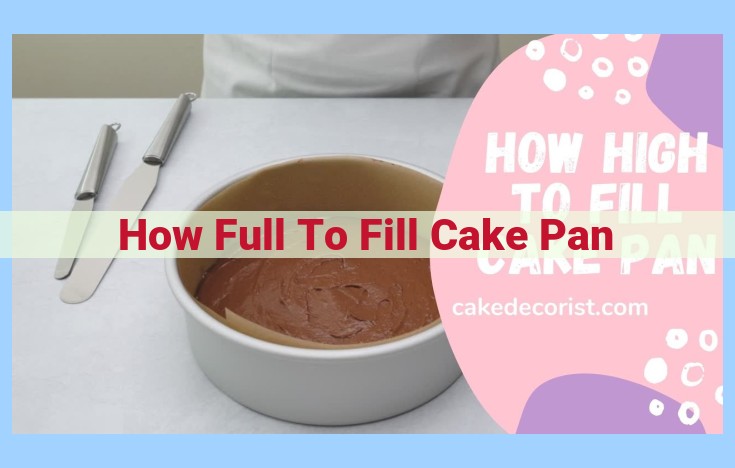Master The Perfect Cake: Achieve Optimal Filling Capacity

To achieve the perfect cake, filling the pan to the correct capacity is crucial. Overfilling can lead to overflowing and a dense texture, while underfilling results in a thin, uneven cake. As a general rule, fill the pan to two-thirds of its capacity. This allows sufficient room for the batter to rise during baking, ensuring an even crust and a moist, fluffy interior.
The Perfect Cake: Essential Components
Embarking on a culinary adventure to create the perfect cake demands meticulous attention to the fundamental elements. One crucial aspect is selecting the ideal cake pan. Consider its size: too small and your cake may overflow, while too large and it could bake unevenly. Shape also plays a role. Round pans yield classic layer cakes, while square or rectangular pans are perfect for sheet cakes. Lastly, choose the right material: metal pans conduct heat evenly, while glass pans require longer baking times.
Equally important is understanding filling capacity. A pan that’s too full will result in a cake that rises excessively and potentially spills over, while a pan that’s too empty will yield a thin and uneven cake. Aim to fill the pan to about two-thirds of its capacity.
Finally, achieving the ideal batter consistency is paramount. Avoid over-mixing the batter, as this can develop the gluten in the flour and result in a tough cake. Use a gentle hand and mix just until the ingredients are combined. The ratio of wet to dry ingredients is also crucial. Too much liquid will make the cake dense, while too little will make it dry. Follow the recipe’s instructions carefully to ensure the perfect balance.
Baking Considerations for a Perfect Cake
When embarking on the culinary journey of baking the perfect cake, meticulous attention to the baking process is paramount. Optimal time and temperature play a crucial role in determining the texture and flavor of the final masterpiece. Different types of cakes require specific baking parameters to achieve their desired characteristics. For instance, a dense, rich chocolate cake may require a lower temperature and a longer baking time to ensure its rich flavors fully develop without burning. On the other hand, a light and fluffy vanilla cake may thrive at a slightly higher temperature for a shorter duration, resulting in a tender crumb and delicate sweetness.
Understanding the telltale signs of a well-baked cake is essential for achieving baking perfection. A golden-brown crust signifies a crisp exterior that locks in the cake’s moisture. The interior should be moist and tender, yielding slightly to the touch without excessive crumbliness. An even crumb throughout the cake indicates an evenly distributed heat during baking, preventing dense pockets or undercooked sections.
Troubleshooting common baking issues is a valuable skill for any aspiring baker. Uneven baking can be rectified by ensuring proper oven calibration and rotating the cake pan halfway through the baking time. Sinking can be prevented by allowing the cake to cool gradually in the pan before inverting it. Dryness can be remedied by adjusting the baking time and temperature or using a richer batter.
Remember, precision and patience are key in the quest for the perfect cake. Accurate measurement of ingredients, preheating the oven to the correct temperature, and allowing the cake to cool properly are all crucial steps that contribute to a successful outcome. By understanding the nuances of the baking process and applying these tips, you can elevate your baking skills and create cakes that will delight both your taste buds and your presentation.
Additional Tips for Baking a Perfect Cake
Measuring Ingredients Accurately
Precision is key in baking. Use measuring cups and spoons specifically designed for cooking, as regular utensils may not provide accurate measurements. For dry ingredients, spoon the ingredient into the measuring cup and level it off with a knife or straight edge. Avoid scooping directly from the container, as this can pack the ingredient and result in too much being added. For liquids, use a clear measuring cup and read the measurement at eye level to ensure accuracy.
Role of Quality Ingredients
The quality of your ingredients plays a crucial role in the final outcome. Use fresh, high-quality ingredients whenever possible. Avoid using stale or expired ingredients, as they can affect the taste, texture, and appearance of your cake. Good-quality ingredients will enhance the flavor and increase the chances of a successful bake.
Preheating the Oven
Preheat the oven to the desired temperature before placing the cake in. This ensures an even bake and prevents the cake from being undercooked in the center or overcooked on the outside. The oven temperature should be accurate, so use an oven thermometer to verify the temperature if necessary.
Cooling the Cake Properly
Once the cake is baked, allow it to cool in the pan for 10-15 minutes before inverting it onto a wire rack to cool completely. This will help prevent the cake from collapsing or breaking. Avoid cutting into the cake while it is still warm, as this can result in a crumbly texture.
Frosting and Decorating
Frosting and decorating your cake can enhance its presentation and make it even more delectable. For a smooth and even frosting, use a pastry bag fitted with a desired tip. Avoid over-frosting the cake, as it can make it overly sweet and difficult to handle. When decorating with sprinkles or other toppings, wait until the frosting has set slightly to ensure they will stick.